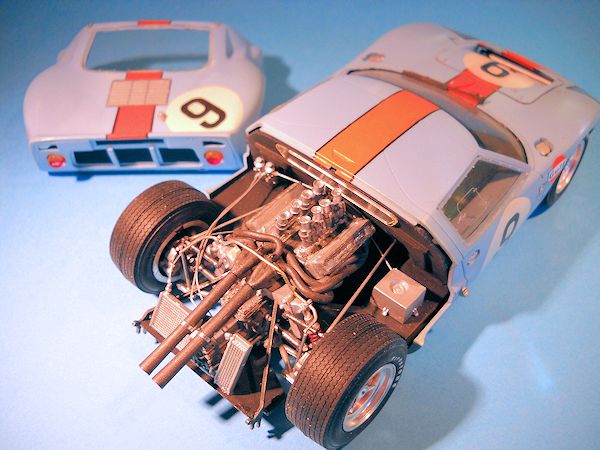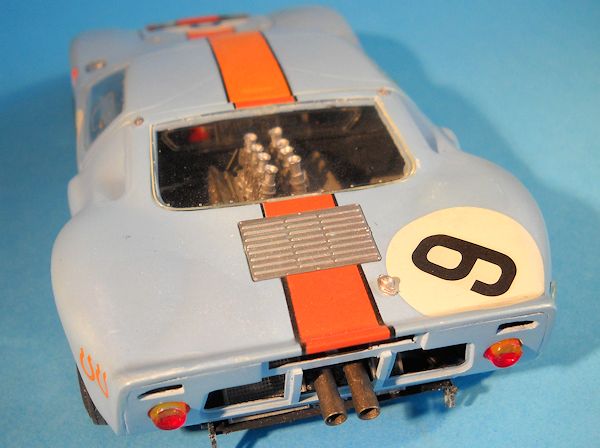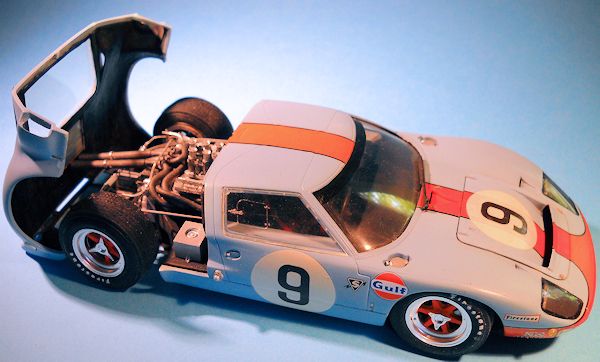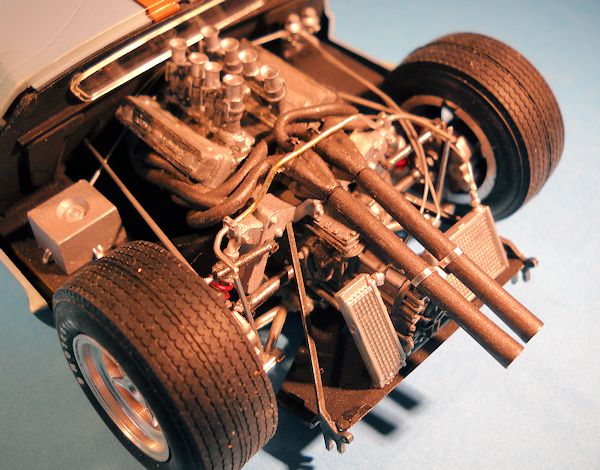
Fujimi 1/24 Ford GT-40 Mk.I
| KIT #: | ? |
| PRICE: | $ |
| DECALS: | One option |
| REVIEWER: | Amin Ghazzaoui |
| NOTES: | Resin engine added |

| HISTORY |
In 1967, the CSI
changed regulations such that a three-litre capacity limit was imposed on
prototypes which eliminated the 427 Fords. Fortunately, J. W.
Automotive Engineering Ltd. (JW) & Gulf Oil, under the capable
direction of John Wyer, saw more potential in the GT40 platform as a Group
4 sports car and extended their GT40 program.
 JW
modified two of their lightweight GT40s from the 1967 season known as the Mirage
M1s. These kept their lightweight chassis, but used carbon-fiber
reinforced bodywork that outwardly mimicked the original GT40 Mk I.
JW
modified two of their lightweight GT40s from the 1967 season known as the Mirage
M1s. These kept their lightweight chassis, but used carbon-fiber
reinforced bodywork that outwardly mimicked the original GT40 Mk I.
In 1968 competition came
from the Porsche 908 which was the first prototype built for the 3-liter Group
6.
The result of the 1968
was resounding success at the 24 Hours of Le Mans with Pedro Rodriguez and
Lucien Bianchi having a clear lead over the Porsches. The season began
slowly for JW, losing at Sebring and Daytona before taking their first win
at the BOAC International 500 at Brands Hatch. Later victories included
the Grand Prix de Spa, 21st Annual Watkins Glen Sports Car Road Race and
the 1000 km di Monza.
A late Le Mans was run in August and was the decider for the International Championship for Makes. With the GT40 win, Ford was again at the top. The winning car, chassis P/1075 repeated history in 1969 by winning Le Mans again.
| THE KIT |
 I was
always fascinated by this world championship sports car racer since I was
a teen. Half a century later and its still a valid and sleek looking high
performance sports car. I chose to build the old Fujimi model le Mans winner
1968 at the hands of Pedro Rodriguez. The kit is very old and the parts are few.
The instructions are not complete and can be
confusing. I
recommend you do some research before you start.
I was
always fascinated by this world championship sports car racer since I was
a teen. Half a century later and its still a valid and sleek looking high
performance sports car. I chose to build the old Fujimi model le Mans winner
1968 at the hands of Pedro Rodriguez. The kit is very old and the parts are few.
The instructions are not complete and can be
confusing. I
recommend you do some research before you start.
| CONSTRUCTION |
I chose to add an engine
to my model. The resin engine is available from
Strada Sports. It has some very deli cate
parts such as the carburettors and must be handled with care. The
big challenge is setting the engine block into the existing suspension arms and
onto the chassis, cutting, filling,
drilling etc is the order of the day. I
added some scratch built parts to the anti roll bar to connect the bottom
wishbone supplied by Strada Sports
and wheel hub stabilizer support rods to the tub wall.
used stretched sprue to add the oil lines from the engine block to oil pump,
reservoir and radiators. the photoetch set is by Studio 27 which does offer a
little more detail such as the harnesses and grills to the radiators. The
fog lamps donít fit, you must modify them or use
another set supplied enabling the clear cover to fit properly. A stopper
is supplied as well to fill in the second petrol gasket should you chose to
build the MK 1 Le Mans racer. The front suspension arm and wheel hubs are very
delicate and must be handled with care, a little filling helps to get the front
wheels turning freely.
cate
parts such as the carburettors and must be handled with care. The
big challenge is setting the engine block into the existing suspension arms and
onto the chassis, cutting, filling,
drilling etc is the order of the day. I
added some scratch built parts to the anti roll bar to connect the bottom
wishbone supplied by Strada Sports
and wheel hub stabilizer support rods to the tub wall.
used stretched sprue to add the oil lines from the engine block to oil pump,
reservoir and radiators. the photoetch set is by Studio 27 which does offer a
little more detail such as the harnesses and grills to the radiators. The
fog lamps donít fit, you must modify them or use
another set supplied enabling the clear cover to fit properly. A stopper
is supplied as well to fill in the second petrol gasket should you chose to
build the MK 1 Le Mans racer. The front suspension arm and wheel hubs are very
delicate and must be handled with care, a little filling helps to get the front
wheels turning freely.
| COLORS & MARKINGS |
 The
orange and black stripes are a mix of paint and kit decals. the gulf blue and
racing orange paints are by Hiroboy. Hiroboy supplies a range of colored
and braided cables should you wish to add them for authenticity to the engine.
the Gulf decals are by speedline . The kit decals are good but the number
roundel is transparent. I used burnt iron color for the exhaust pipes, magnesium
for the gearbox, aluminium, chrome and steel for the engine. The colors
are by MM, Gunze and Revell. i did not flatten the chrome wheels supplied. i did
apply two coats of gloss to the body since the gulf blue is extremely flat. I
believe they leave it up to you to reach the shade you fancy. I used Gunze white
as primer. I airbrushed tyre black by Gunze for the bucket seats. The tub is
flat black.
The
orange and black stripes are a mix of paint and kit decals. the gulf blue and
racing orange paints are by Hiroboy. Hiroboy supplies a range of colored
and braided cables should you wish to add them for authenticity to the engine.
the Gulf decals are by speedline . The kit decals are good but the number
roundel is transparent. I used burnt iron color for the exhaust pipes, magnesium
for the gearbox, aluminium, chrome and steel for the engine. The colors
are by MM, Gunze and Revell. i did not flatten the chrome wheels supplied. i did
apply two coats of gloss to the body since the gulf blue is extremely flat. I
believe they leave it up to you to reach the shade you fancy. I used Gunze white
as primer. I airbrushed tyre black by Gunze for the bucket seats. The tub is
flat black.
| CONCLUSIONS |
| REFERENCES |

http://www. supercars.
net/cars/691. html#HPvf8IGbquEK8lZq. 99
Amin
Ghazzaoui
November 2013 If you would like your product reviewed fairly and fairly quickly, please
contact
the editor or see other details in the
Note to
Contributors.